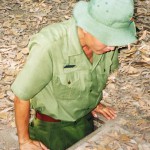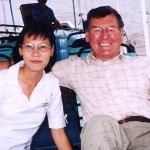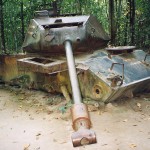By Granville Bantick
In my last article I described my experiences of being part of a sponsored bike ride in Vietnam raising money for Mencap. Following the departure of my cycling friends I stayed on at the Viet Dong Hotel in Saigon, having arranged a three day tour of the Mekong Delta.

I had extended my stay in Vietnam for a further eight days. I had extra days to take in some local tours and one of these was to visit the Cu Chi Tunnels.

Mekong in pleasant
company
At first glance, there was little evidence to indicate the intense fighting, bombings and destruction that went on in the town of Cu Chi during the war. To see what went on one had to dig deeper – underground. The tunnel network of Cu Chi became legendary during the 1960s for its role in facilitating Viet Cong control of a large rural area only 30-40 km from Saigon. So vast was the tunnel system that at its height it stretched from the South Vietnamese capital to the Cambodian border. In the district of Cu Chi alone there were more than 250km of tunnels. In some parts of the net work the tunnels were several storeys deep, including innumerable trap doors, specially constructed living areas, storage facilities, weapons factories, field hospitals, command centres and kitchens. The tunnels made possible communications and coordination between the VC-controlled enclaves, isolated from each other by South Vietnamese and American land and air operations. More importantly it enabled the VC to mount surprise attacks, and to disappear into hidden trap-doors without a trace. These ground operations claimed a large number of casualties. This prompted the Americans to mount a blitz rig against the VC with massive fire-power, eventually turning Cu Chi into the most bombed, shelled, glassed, defoliated and generally devastated area in the history of warfare so it is claimed. This did not stop the VC in mounting stunning attacks in the South Vietnamese capital during the 1968 Tet Offensive which was launched from Cu Chi. The Americans under orders of President Johnson endeavoured to pacify the area but without success despite tens of thousands of troops being employed. Their tenacity was extraordinary considering the bombings. Eventually the Americans were ordered home. But of the 16,000 cadres who fought in the war only 6,000 survived. The war’s savagery and brutality is depicted in detail in the War Museum in Saigon which I visited during my stay, and remains etched on my mind.
Army Fatigues
I was taken by a Vietnamese guide, dressed in army fatigues, to a tunnel entrance which had been camouflaged by leaves. The entrance was too narrow for me to enter but he was able to drop down into the tunnel being so small. This was another reason why the Americans had difficulty infiltrating the tunnel system. I was shown some dastardly booby traps and man traps which were camouflaged in the ground. The American ground troops had no chance. I was able to go down one specific entrance open to visitors into the tunnel system. I had to crawl on my hands and knees for 60 metres in semi darkness with one light to indicate the exit. It was a horrible experience and one wonders how the guerrillas managed to survive. They made weapons in underground forges from shrapnel and sandals from the tracks of American tanks they had blown up. There was no end to their ingenuity. My tour ended with a visit to a firing range where I was able to fire off a few rounds with an American M16 rifle. It was all a fantastic experience and made me realise how futile the Vietnam war was.
Wrecked American Tank
A day or two later another Vietnamese guide picked me Relaxing on the Mekong in pleasant company Viet Cong Tunnel Entrance up from my hotel. She was called Trang, and worked for a local agency which was connected to my London agents, Trail-finders, through whom I had booked my tour. I was whisked away in a luxurious air-conditioned car to the Mekong Delta which was 100 miles from Saigon. The Mekong Delta is pancake flat, but lusciously green and beautiful. It is the southern-most region of Vietnam. It was formed by the sediment from the Mekong river, a process which continues to this day extending the shoreline by as much as 79 metres per year. It is known as Vietnam’s “bread basket” although “rice basket” would be more appropriate. The Mekong Delta produces enough rice to feed the entire country, with a sizable surplus. Vietnam is the biggest exporter of rice after Thailand.
Two Guides
On arrival I transferred to a boat, and Trang introduced me to another guide who specialised in tours of Mekong Delta. His name was Vu, and both of them were to accompany me on my journey. The boat was a long narrow craft driven by a Vietnamese woman (all boats are driven by women as their husbands work in the fields). It felt rather strange all these people taking me on a tour of the Mekong Delta and I was the only tourist! However, I felt privileged. I was able to converse with my guides as they were reasonably fluent in English. On the first day we stopped at several places of interest including seeing how rice paper was made. We glided up the tributaries of the Mekong River and its canal system. We passed beautiful scenery – banana plantations interwoven with palm trees right down to the water’s edge. Nets could be seen hanging in the water to catch fish. Behind this fringe of waterside greenery and wild flowers lay a vibrant village life with narrow paths for transporting the produce to the river boats which would take the produce to the floating markets. These I would visit later.
It was late afternoon and the sun was dipping the palm trees creating silvery patterns on the smooth water when around a bend in the river there appeared a dwelling supported by wooden poles in the water. Our boat slowed and was tied up to the pontoon. This was the homestead where I would spend the night with a Vietnamese family. I was warmly greeted by my hosts, and shown to my quarters – a dormitory of six beds from which I could choose, over each which hung a mosquito net. It was dimly lit and the water beneath me shone in the moon light through the half inch gaps in the floorboards (one was careful not to drop ones keys!) The beds were narrow and basic but I had been left with towel and soap neatly placed at the bottom of my bed. I joined the family and had my meal prepared on the veranda. It was to consist of an elephant ear fish, set upright supported by decorated sticks. The accompany side dishes were basically vegetables locally grown cooked in different sauces. The way to eat these delicacies was to place a portion of the fish and side dishes with ones chop sticks on to the rice paper, pour a little of the soya and fish sauces over the mixture and wrap it up into a parcel and eat it. It took a little practice and several dozen napkins this operation! Another interesting experience.
I did not sleep terribly well and was woken frequently during the early hours of the morning by the noise of river craft plying their way to market. It was a beautiful tranquil spot and I was sorry to have a leave that morning. Life begins early in the day in Vietnam, and we had to reach the floating markets by 10am if we wanted to see “the action”. Already a steady stream of boats laden with fruit and vegetables were making there way along the waterways to the market. The heat of the sun was really felt in an open boat, and I was pleased to have been wearing my old Australian bush hat. I must say I felt like Crocodile Dundee in these parts but as far as I know there were no crocodiles! We followed the procession of boats, and after a while where the river widened, we saw ahead dozens of bobbing boats tied jostling to reach the larger ones which I was told were the “wholesalers” and some others which were the “retailers”. Each “Wholesaler” had a fruit or vegetable tied to the top of a pole to indicate his speciality, and the farmers’ wives did all the market transactions from their boat which often looked a precarious activity. It was a very colourful scene and was well worth the visit.
In the afternoon, we explored narrower waterways which were mainly canal channels. It amazed me how we never got lost! The palm trees on each side almost touched across the water in places and we passed under “monkey bridges” – crudely cut bamboo poles tied together across the river over which neighbours could walk and visit each other. They are attractive constructions but did not look very safe. Further on as the sun again started to dip we stopped and moored up to visit a stork sanctuary. I had to climb a spiral staircase to a viewing platform. What I saw was tens of thousands of white (and some black) storks sitting in the trees looking all the more like a lot of tissue paper that had blown there in a gale. I dread to think how much fish had to be supplied to keep them. It was an unusual sight to see so many of one breed of bird.
Last Night Luxury
Finally, the last night was spent in what “Lonely Planets” described as the most luxurious hotel in south east Vietnam. What a contrast to the previous night! The bedrooms with en-suite bathrooms and sumptuous furnishings overlooked the palm fringed swimming pool around which visitors lounged in peacock chairs sipping cocktails. The hotel overlooked the Mekong river and the town of Mytho on the opposite bank which could be reached by the private boat for guests at the jetty. Dinner was another experience in such luxurious surroundings, with an accompanying musician playing at my table.
The journey back to Saigon was in pouring rain, the first real downpour of my time in the country. I sat back and mused at the last two weeks and felt very privileged to have been able to experience so much. Vietnam is a wonderful country. It has shaken off the ghastly war years and is moving fast into the 21st Century. It has a long way to go before catching China, but it is definitely on the move, and tourists should not wait too long before the face of today’s Vietnam becomes too commercialised. I had one last night in my hotel in Saigon before leaving for the airport for the long flight home. I spent it at my favourite eating house in the city, the “Lemon Grass” (highly recommended), and whiled away a few hours at the “119 Club” afterwards sipping a cocktail and being entertained by some very westernised pop groups and stage acts, and talking to the locals with whom I had long conversations. The Vietnamese are a very friendly people. I shall never forget their warmth and hospitality, and this perfectly beautiful country.
Farewell Vietnam!
From “Rye’s Own” March 2004
All articles, photographs, films and drawings on this web site are World Copyright Protected. No reproduction for publication without prior arrangement. (Hard Copy Back Numbers Still Available) © World Copyright 2017.
